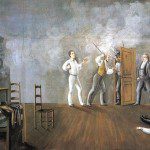John Turner, Assistant Professor of Religious Studies at George Mason University, has had a very busy schedule this fall, as he’s been travelling throughout the country on a sort of scholarly junket to promote his new book, Brigham Young: Pioneer Prophet. He’s done interviews with KSL Radio, National Review Online, and Mormon Stories, visited Utah State University, Brigham Young University, and Baylor University, and will be heading down to southern California this week to speak at Claremont Graduate University and the Miller-Eccles Study Groups. Reviews from academic journals will no doubt begin appearing in the not-too-distant future, but a handful of reflections in more popular venues and blogs are out, and the general consensus is that Turner has produced a landmark publication. I haven’t read it cover to cover yet, but I have had a chance to look over several significant sections, and I think it’s reasonable to assume that just as Richard Bushman’s Rough Stone Rolling became the definitive contemporary biography of Mormonism’s founding figure, Pioneer Prophet will become the same for Mormonism’s Moses.
Julie Smith reviewed the book over at Times and Seasons, and one of the main feelings she came away with was that although it will likely “be the definitive biography of Brigham Young for the next few decades . . . it may also be a troubling thing, at least for some people.” She has “serious reservations about recommending it to the average church member,” because it paints an uncomfortable picture that unabashedly includes the kind of warts and all material that made Young such a complex, compelling, and controversial figure. For her the text revealed a far more flawed human than a powerful prophet, so, unlike Rough Stone Rolling, Turner’s treatment has significantly decreased her appreciation and respect for the nineteenth-century American religious icon. Most importantly, it left her unsure why people would have made such enormous sacrifices for Young. As a result, she thinks ”there is a substantial risk that people raised on hagiographic, presentist images of prophets would have their testimonies rocked, if not shattered, by this book.”
If she’s right, then just exactly what kind of thing is a testimony anyway? This was Adam Miller’s question in a follow-up post, “Don’t Read That! Your Testimony Will Be History!” Adam thinks Julie’s reservations about recommending it to the average member are probably right, but then poignantly puzzles over what that might mean for the very notion of testimony. He’s literally puzzling here, because his entire post is just one long series of questions, so he’s apparently inviting the reader to try and find a way to fit a few seemingly misshapen pieces together. “What kind of testimony is capable of being rocked or even shattered by Turner’s brand of honest but unfiltered history? . . . What does it mean about the relationship between our church history and our spiritual work if a testimony can be historically ignorant about basic facts and still be genuinely valid and efficacious?” What does it mean to have a testimony in a religion whose truthfulness has been so intimately intertwined with the past, and yet its past is often filled with the same sorts of ambiguities and ugliness that can be found in every other human institution?
This isn’t the appropriate venue to try sort through the countless complexities involved with the notion of testimony in contemporary Mormonism, but I do want to offer a few modest suggestions by way of an initial response to Adam’s provocative post. Like him, I have far more questions than answers, but hopefully I can identify a proper placement for at least a couple of pieces. Once a month, in every Latter-day Saint congregation across the world, members gather together to participate in what’s called a ‘fast and testimony’ meeting. The fasting part of the meeting means that members are encouraged to go without food or water for two meals, and donate the money that would have been used for those meals (more if one can afford it) to those who are in need. It is during this period of fasting, this period in which one sacrifices some of one’s own deepest desires, this time of concern for that which is other than the self; it is during this period of situating oneself in a kind of sacred time that Latter-day Saints gather together in a sacred space to spontaneously share their testimonies with each other. One by one men and women, boys and girls, and even the littlest ones who may have only just recently acquired the ability to speak, stand and bare their souls in front of their fellow congregants.
“I’d like to bear my testimony,” begins nearly every young child, “that I know the church is true. I love my mom and dad and my brothers and sisters [if they have any]. I know Joseph Smith is a prophet. I know the Book of Mormon is true. In the name of Jesus Christ, amen.” Often repeated virtually verbatim by the youngest—to the consternation of some and inspiration of others—this represents the most immature expression of a testimony. Those with more life-experience and a deeper spiritual understanding will inevitably develop their own way of articulating their witness, but it will usually include some variation of the following statements: “I know that God lives.” “I know that Jesus is the Christ.” “I know Book of Mormon is true.” “I know that Joseph Smith is a prophet of God.” “I know that the church is true.” “I know that Thomas S. Monson is God’s prophet on the earth today.” “I know that God hears and answers prayers.” Testimonies may differ widely from person to person, but clearly the affirmation of one’s knowledge of these sorts of truth-claims is important, personal stories are commonly shared to lend support to their claims, and gratitude is often expressed—indeed, what is jokingly referred to as “thank-you-mony” isn’t at all uncommon. Thus, while it’s true that testimonies are more like fingerprints than photocopies, most speakers tend to adhere to a fairly familiar script that’s not entirely unlike to the one repeated by the young children.
But where do testimonies come from? How are they acquired? “No single doctrine distinguishes Mormonism more sharply than the belief in direct revelation.” writes Richard Bushman, “It underlies everything from the governing authority of the church to every Mormon’s daily life.” The notion of revelation, or communication with or inspiration from the Divine, is absolutely central to the self-understanding of Mormonism, and one of its primary functions is to provide “individual Mormons with a ‘testimony,’” which Bushman sees as “one of the most potent words in the Mormon lexicon.” Latter-day Saints believe that revelation
can confirm the truth of the gospel of Christ and the words of the prophets. All the basic beliefs, including the existence of God, his willingness to answer prayers, the atonement of Christ, the prophetic calling of Joseph Smith, the veracity of the scriptures, and the continuance of revelation down to the present, are components of a standard Mormon testimony. The truth of it all can be known, they believe, by inspiration sought through prayer.
Accordingly, the goal of every LDS missionary is that his or her potential converts will pray to receive their own spirit-filled confirmation of the church’s foundational truth-claims.[1]
A testimony is absolutely vital, it is held, because it is the only way to weather the storm of non-religious ways of thinking about and being in the world. The founding narratives, such as Joseph Smith’s first vision, angelic visitations, gold plates, translating ancient texts are viewed as absolutely incredible to many, and a divine confirmation of their truthfulness is the only way to combat the skepticism that tends to dominate modern secular sensibilities. LDS leaders and parents alike know that young people have a much greater chance of avoiding the pursuit of alternative paths and remaining faithful to the fold if they receive a personal divine witness of church teachings and practices. Thus, the entire church program, Bushman observes, “is designed to instill that testimony in the rising generation.” Every Mormon parent hopes and prays that “their children will gain testimonies that the ‘gospel is true.’ If they do, everything else will fall into place.”[2]
Just over a week ago Thomas S. Monson, the President and Prophet of the LDS Church, reiterated this very message at a global gathering of Mormon men stating that there “is absolutely nothing in this world that will provide more comfort and happiness than a testimony of the truth,” and that in order to help those who lack a witness of their own priesthood holders should “develop the capacity to see men not as they are at present but as they may become when they receive testimonies of the gospel of Christ.” As helpful as such admonishments are for inspiring the faithful, however, the force of Adam Miller’s line of questioning remains. What kind of a thing is a testimony if it has the potential to be decimated by an account of the church’s past that is accurate but less attractive than that provided by the Correlation Department? Could it be that the difficulty here isn’t so much with testimony per se, but that upon the basis of which testimonies are often constructed?
What does it mean to say, “I have a testimony . . . ” or, “I’d like to bear my testimony . . . ” or, “I lost my testimony.” anyway? All this ‘I’ talk and ‘my’ talk indicates that a testimony is the sort of thing that a person can, and indeed must, possess for oneself. And, if that’s right, if it is a personal possession, then is having a testimony anything like owning a bicycle or a car or a house? If a testimony is under the ownership of individuals, is it something that can be controlled or manipulated or handled according to one’s desire? Is it a kind of tool that is useful for a particular purpose, one that can be brought out from time to time to complete a given task, like standing and speaking in front of a congregation or on a doorstep? Clearly it’s right to say that individual persons possess individual testimonies, that each one is as unique as the person to whom it belongs, but what kind of possession is it?
Might it be the case that the whole notion of possessing a testimony is exactly backwards? Could it be that a testimony possesses you instead of you possessing it? What if a testimony has you, gains you, determines you, and shapes you rather than the other way around? If so, then perhaps having a testimony isn’t so much like owning an object as it is like having a brain or a body. Perhaps it’s a vital organ, a constitutive element of who and what you are, because it defines the most significant part of your very being, and so impacts your entire self-understanding. In fact, all this talk about bearing a testimony seems somewhat strange to begin with, because isn’t its significance seen in the baring of it? “I’d like to bear my testimony . . . “ Shouldn’t it be, “I’d like to bare my testimony . . . ”? Of course, one might say, “Now you’re just playing a semantic game, because everyone knows what the word ‘bear’ means in relation to giving testimonies, even if there’s another commonly accepted meaning.” Perhaps, but what if the activity of speaking words or writing sentences falls far short of capturing the meaning and import of the phenomenon of testimony? What if bearing a witness means, first and foremost, being weighed down by something, carrying a burden, feeling a heaviness of heart, or holding a soul captive by a claim?
If so, then gaining a testimony isn’t so much about learning historical facts and acquiring knowledge as it is about coming to an understanding and being acquired by truth. And, if so, then having a testimony is much more like having a heart than having an iPhone. Once it’s a part of your soul a certain way of life opens up; you become spiritually alive to certain possibilities. Once it’s no longer present within you a certain way of life ceases to be; you become spiritually dead to certain possibilities. This means that when we look closely at what’s happening during the bearing of testimony each testator is baring something profoundly intimate about him or herself—holding out for all to see what it is that holds one firmly within. Put differently, one’s testimony has been borne to the extent that something hidden or concealed within the deepest reaches of his or her soul has been revealed or manifested. In short, to bare a testimony is to give expression, verbally or otherwise, to a self-revelation.
Correspondingly, to bear a testimony is to be weighed down by a witness of faith, because one has received a revelation that can no longer be resisted. What might be going on in fast and testimony meetings, then, is the unburdening of the weighted-down soul, the unyoking of the traveler’s travail, the uncoiling of the knotted knowledge that grants ultimate meaning to one’s entire existence. And, when listeners pay close attention, feel with compassion, and experience the spirit of inspiration by which it is spoken, it may be said that they genuinely bear one another’s burden that they may be light.
Recall the story of Joseph Smith, as told by his mother, about how he felt after the three witnesses received the same soul-wrenching witness that had been his alone to walk with.
On coming in, Joseph threw himself down beside me, and exclaimed, ‘Father, mother, you do not know how happy I am: the Lord has now caused the plates to be shown to three more besides myself. They have seen an angel, who has testified to them, and they will have to bear witness to the truth of what I have said, for now they know for themselves, that I do not go about to deceive the people, and I feel as if I was relieved of a burden which was almost too heavy for me to bear, and it rejoices my soul, that I am not any longer to be entirely alone in the world.’[3]
Notice that the angel “bared” his testimony of that which he had “beared” for so long, simultaneously revealing and relieving Smith, and perhaps even himself as well, of the extraordinary burden that held their hearts with such heaviness. The three witnesses were in turn called to bear the same witness by carrying the same burden and baring the same testimony. It is thus somewhere in the weightiness of the witness of faith that living, breathing, wrenching testimonies are found.
Schubert Ogden, a Protestant systematic theologian, talks about bearing witness as an expression of one’s entire way of being in the world, both secular and religious, and a fundamental manifestation of the most basic self-understanding that is authorized by a given religion.[4] To take an example that is familiar to most Mormons, as a part of their grand cosmological vision, Joseph Smith and Sydney Rigdon wrote the following famous words:
And now, after the many testimonies which have been given of him, this is the testimony, last of all, which we give of him: That he lives! For we saw him, even on the right hand of God; and we heard the voice bearing record that he is the Only Begotten of the Father—That by him, and through him, and of him, the worlds are and were created, and the inhabitants thereof are begotten sons and daughters unto God.”
This witness, so fundamental to the self-understanding of Mormonism, that Jesus is the Son of God, the creator and redeemer of worlds, is explicitly authorized through the dialogical revelations that bind the community together. Accordingly, it is the burden of every Latter-day Saint to both bear and bare this witness in everything they say and do, because it has been revealed to them and so is sewn into the very fabric of their souls.
If this at all captures something of the phenomenon of testimony, then neither bearing nor baring one is finally about the acquisition of knowledge in anything like the intellectual sense. Nor are testimonies mere statements that affirm propositional truth-claims in anything like the philosophical sense. Testimonies are precious private property because they take possession of the soul in the most profound way possible. To have a testimony is to be held captive by a certain claim, to be burdened by a certain weight, to be called to a certain kind of faith, and to be authorized to live a certain kind of life. And, inasmuch as it includes the affirmation of a certain knowledge of some truth-claim testimony is an explicit expression of the witness that is implicit in everything a believer says and does and is.
If this is so, then perhaps a greater amount of trust ought to be placed in what Latter-day Saints take to be the ultimate source of testimony, and less worry given to what might happen when one comes to an awareness of the messy and discomforting truth that is present in virtually every past. Further still, perhaps the truth about the past ought always to be frankly acknowledged and fully embraced, no matter how difficult and painful, calm in the assurance that the truth of revelation is capable of taking care of the truth of history.
Endnotes
[1] Richard Bushman, Mormonism: A Very Short Introduction (2008), 27-8.
[2] Ibid., 30-1.
[3] Lucy Mack Smith, History of the Prophet Joseph by His Mother Lucy Smith (1902), 139 (chapter 31).
[4] Schubert Ogden, Doing Theology Today (1996), 3-35.











